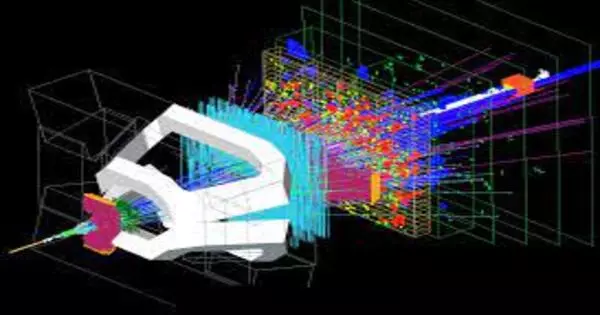The LHCb collaboration presented an analysis of particle collisions at the Large Hadron Collider (LHC) at the Quark Matter conference today and at the recent Rencontres de Moriond conference, which may help determine whether or not any antimatter seen by experiments in space originates from the dark matter that holds galaxies like the Milky Way together.
The fraction of antiprotons, the antimatter equivalents of protons, in high-energy particles known as cosmic rays has been identified by space-based experiments such as the Alpha Magnetic Spectrometer (AMS), which was assembled at CERN and is deployed on the International Space Station. These antiprotons could be formed when dark-matter particles clash, but they could also be formed when protons smash into atomic nuclei in the interstellar medium, which is primarily composed of hydrogen and helium.
To determine whether any of these antiprotons are formed by dark matter, physicists must estimate how frequently antiprotons are produced in collisions between protons and hydrogen as well as protons and helium. While some measurements of the first have been done, and the LHCb reported the first-ever detection of the second in 2017, that LHCb measurement involved only prompt antiproton production—that is, antiprotons generated directly where the collisions occurred.
“This result complements our previous measurement of prompt antiproton production, and it will improve the predictions of the models, This improvement may in turn help space-based experiments find evidence of dark matter.”
LHCb spokesperson Chris Parkes.
In their latest study, LHCb researchers looked for antiprotons produced at a distance from the collision center through the change, or “decay,” of particles termed antihyperons into antiprotons. The LHCb researchers, who normally use data from proton–proton collisions for their investigations, used data from proton–helium collisions obtained by introducing helium gas into the location where the two LHC proton beams would ordinarily clash to achieve this new measurement and the prior one.
By analyzing a sample of 34 million proton–helium collisions, the LHCb researchers discovered that, at the collision energy scale of their measurement, the antiprotons produced via antihyperon decays contribute much more to the total antiproton production rate than the amount predicted by most models of antiproton production in proton–nucleus collisions by measuring the ratio of the production rate of antiprotons from antihyperon decays to that of prompt antiprotons.
“This result complements our prior detection of prompt antiproton generation, and it will improve model predictions,” LHCb spokesperson Chris Parkes said. “This advancement may, in turn, aid space-based research in their search for evidence of dark matter.”
“Our technique of injecting gas into the LHCb collision spot was originally developed to quantify the magnitude of the proton beams,” says Niels Tuning, LHCb physics coordinator. “It’s great to find that it also enhances our understanding of how frequently antimatter should be formed in cosmic collisions between protons and atomic nuclei.”





